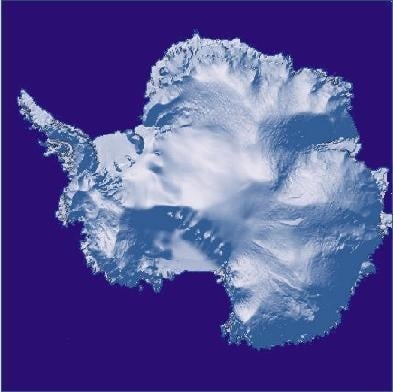Antarctic Ice Sheet and Radar Altimetry: A Review
Abstract
:1. Introduction
1.1. The Antarctic Ice Sheet
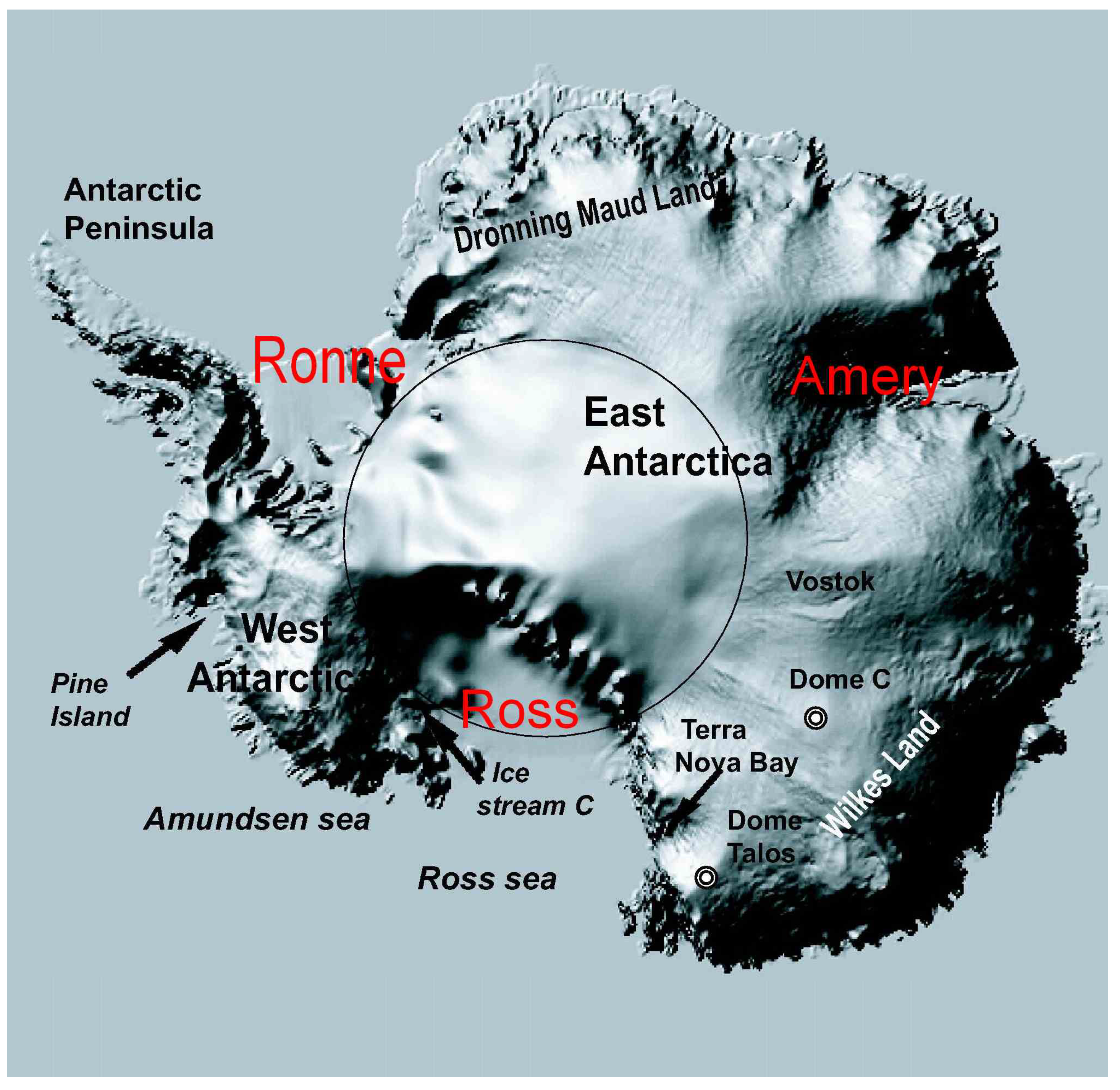
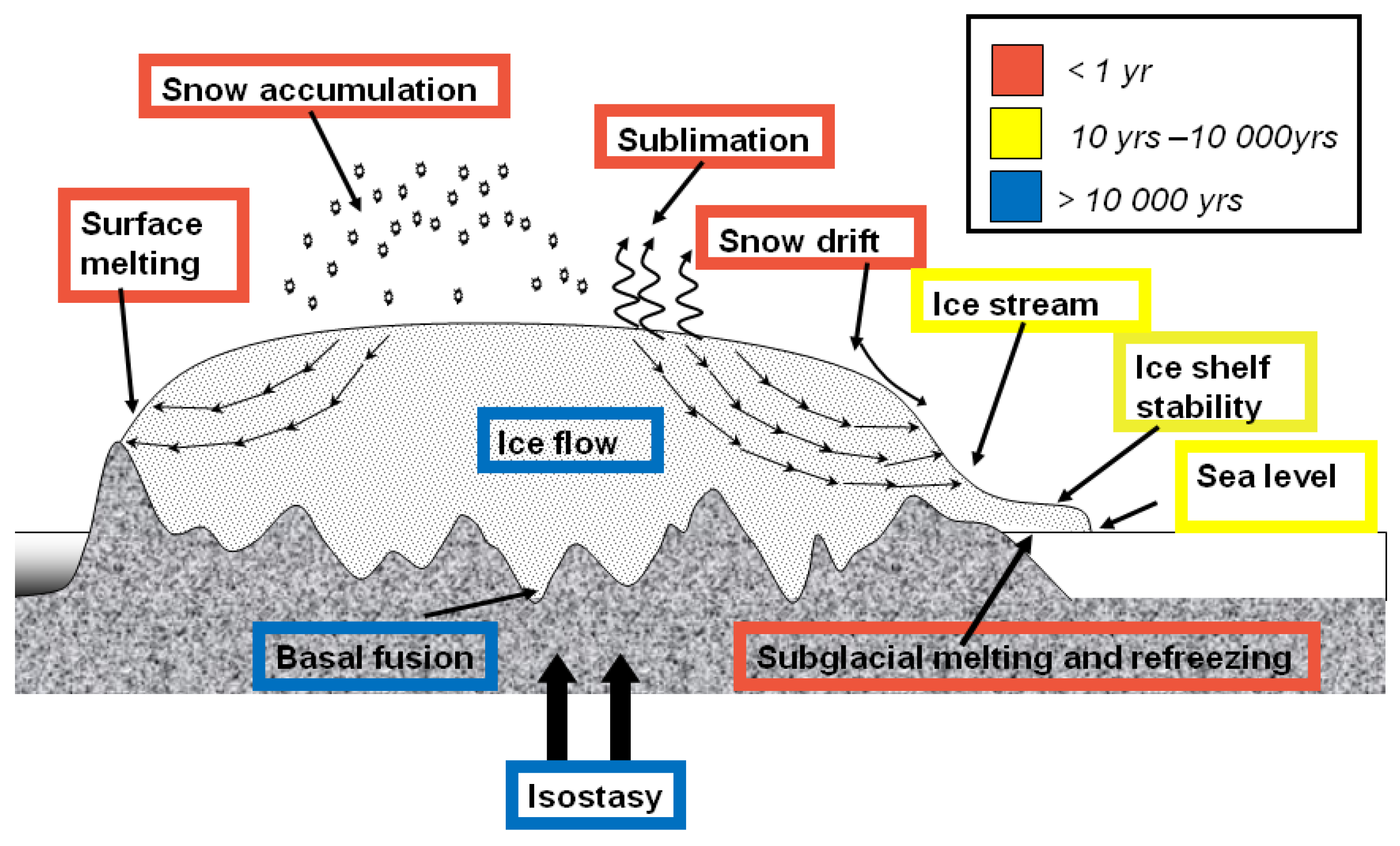
1.2. Observations of the Antarctic Ice Sheet
2. Radar Altimetry
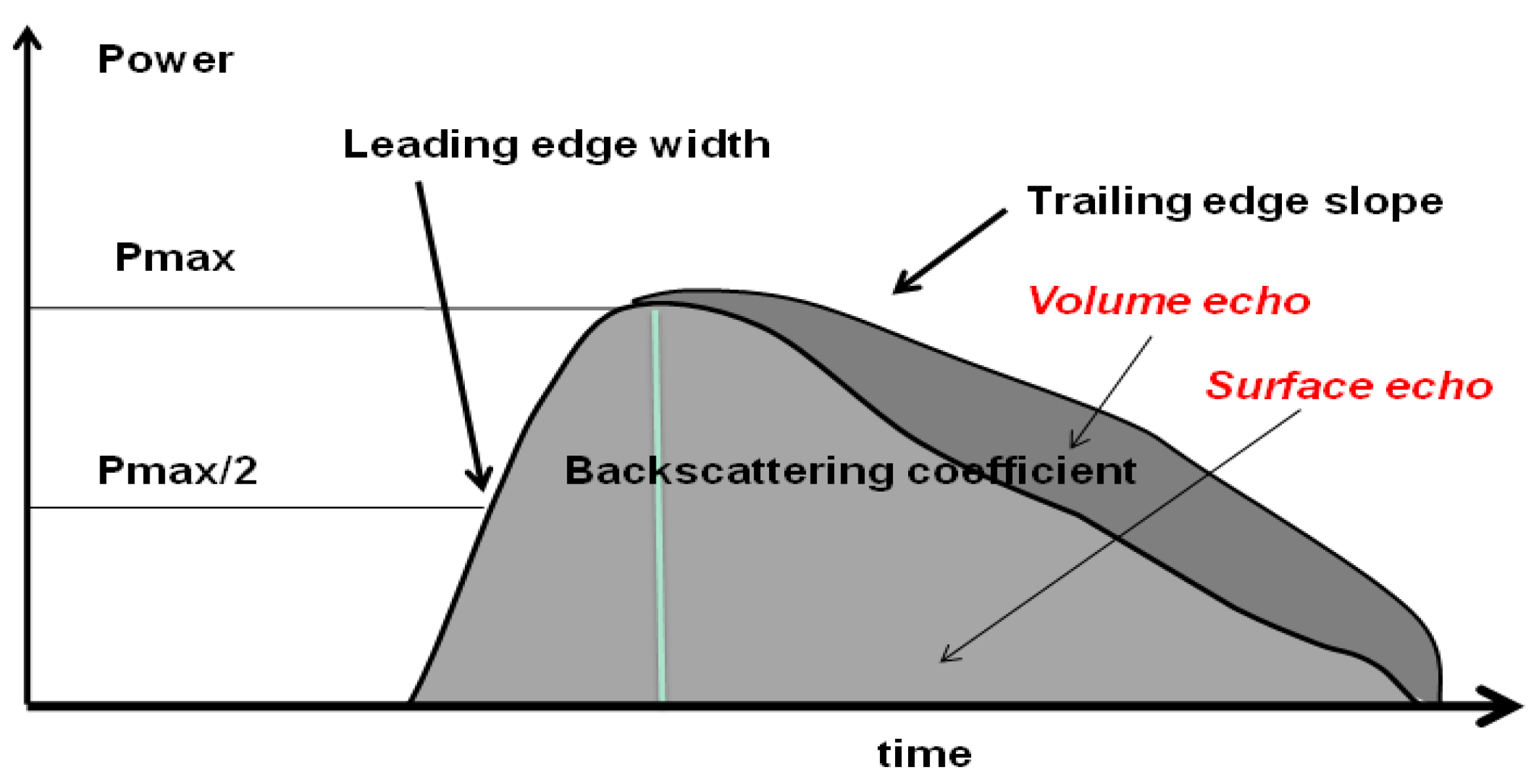

3. Altimetric Waveform Shape, Surface and Subsurface Parameters
3.1. Relation between Waveform Shape and Geophysical Parameters
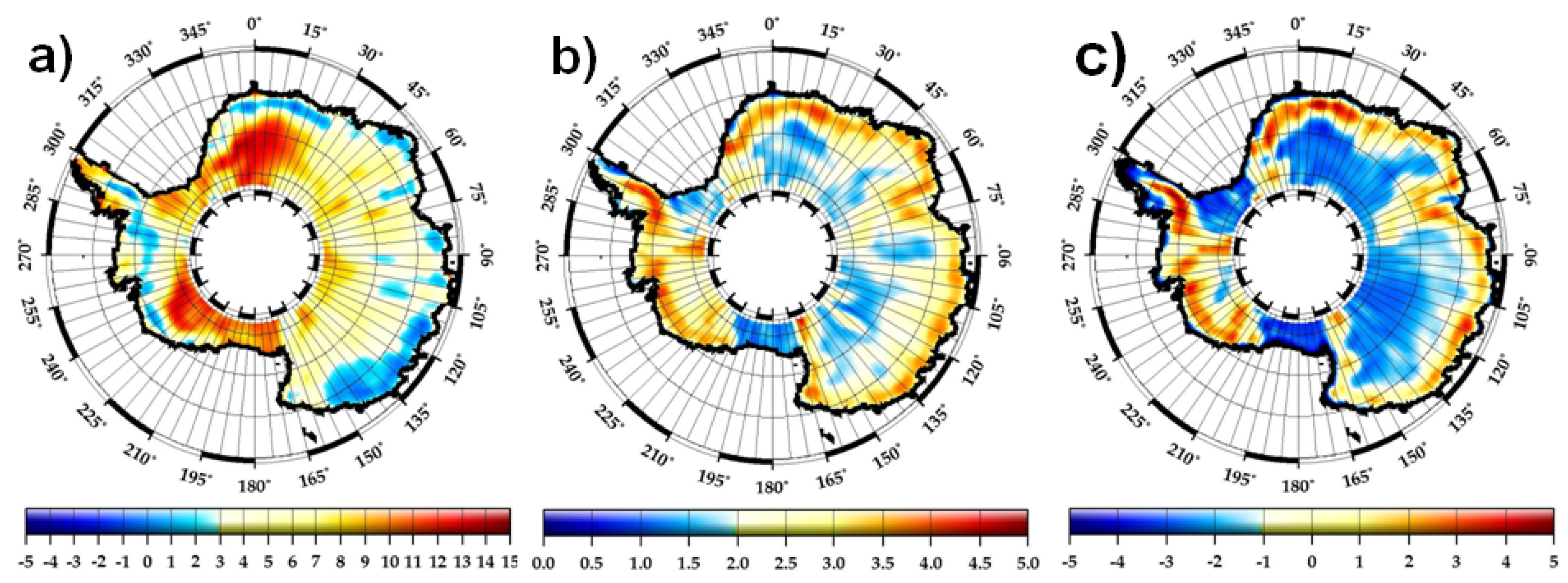
3.2. Dual-Frequency Observations
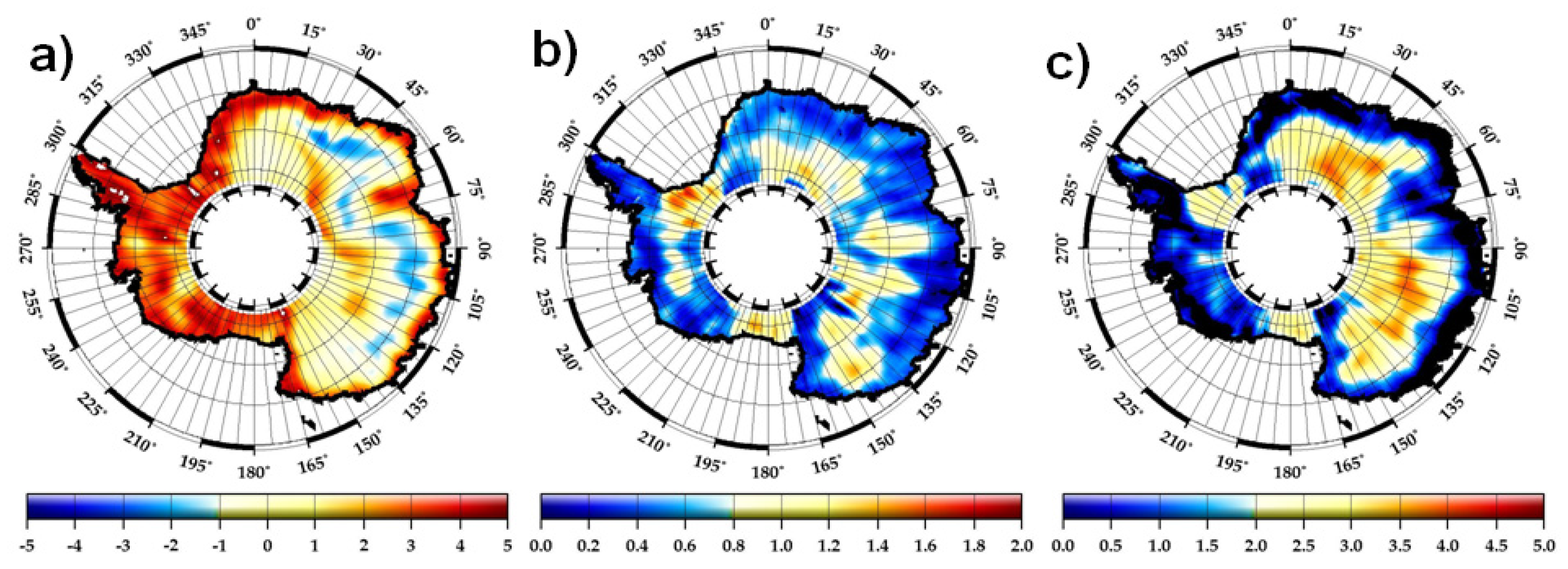
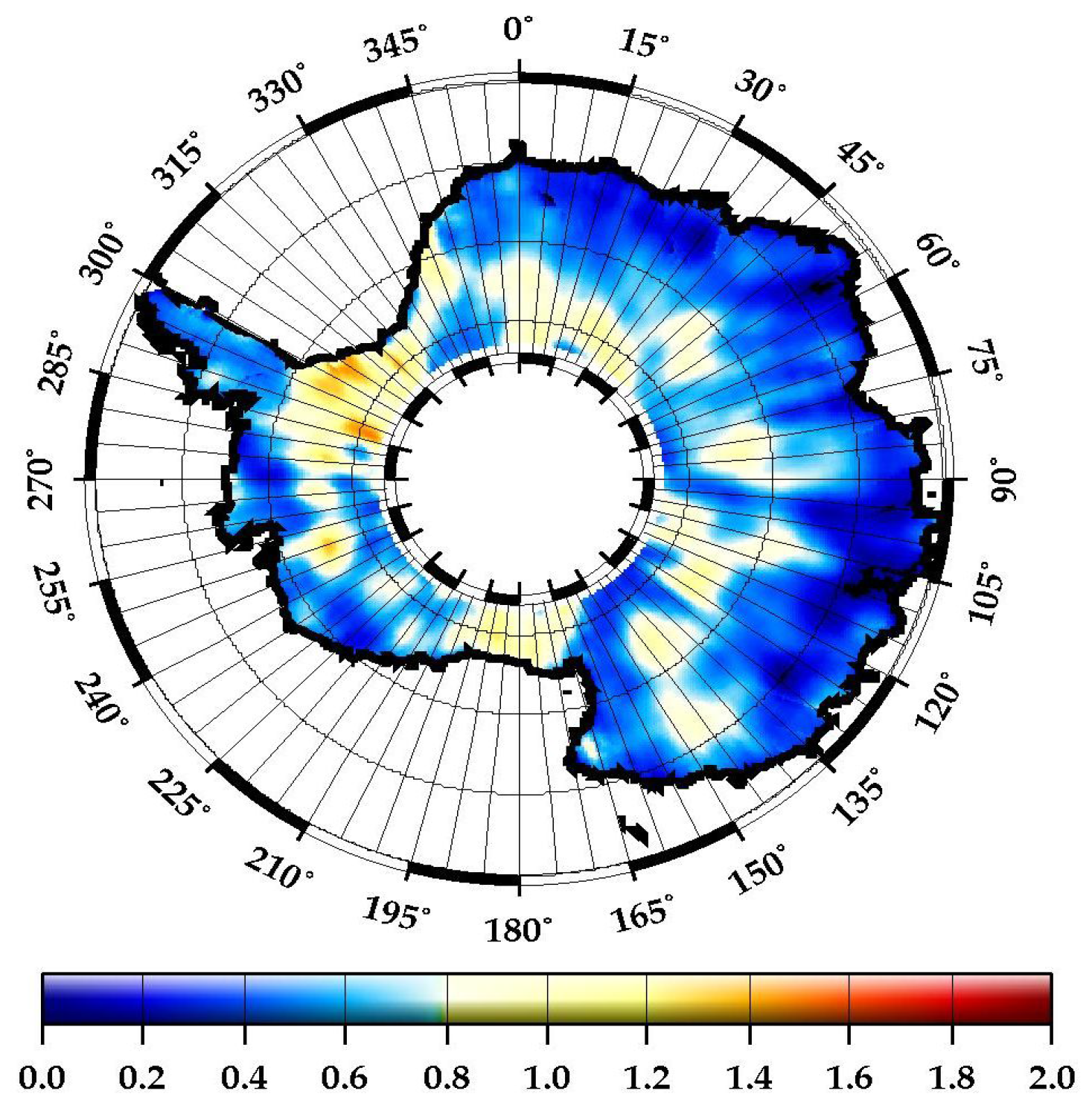
3.3. Toward the Restitution of Some Snow Parameters
4. Application of Radar Altimetry for Ice Sheet Dynamics Study
4.1. Construction and Precision of the Derived Topography
4.2. Ice Dynamics Information Derived from Topographic Signatures
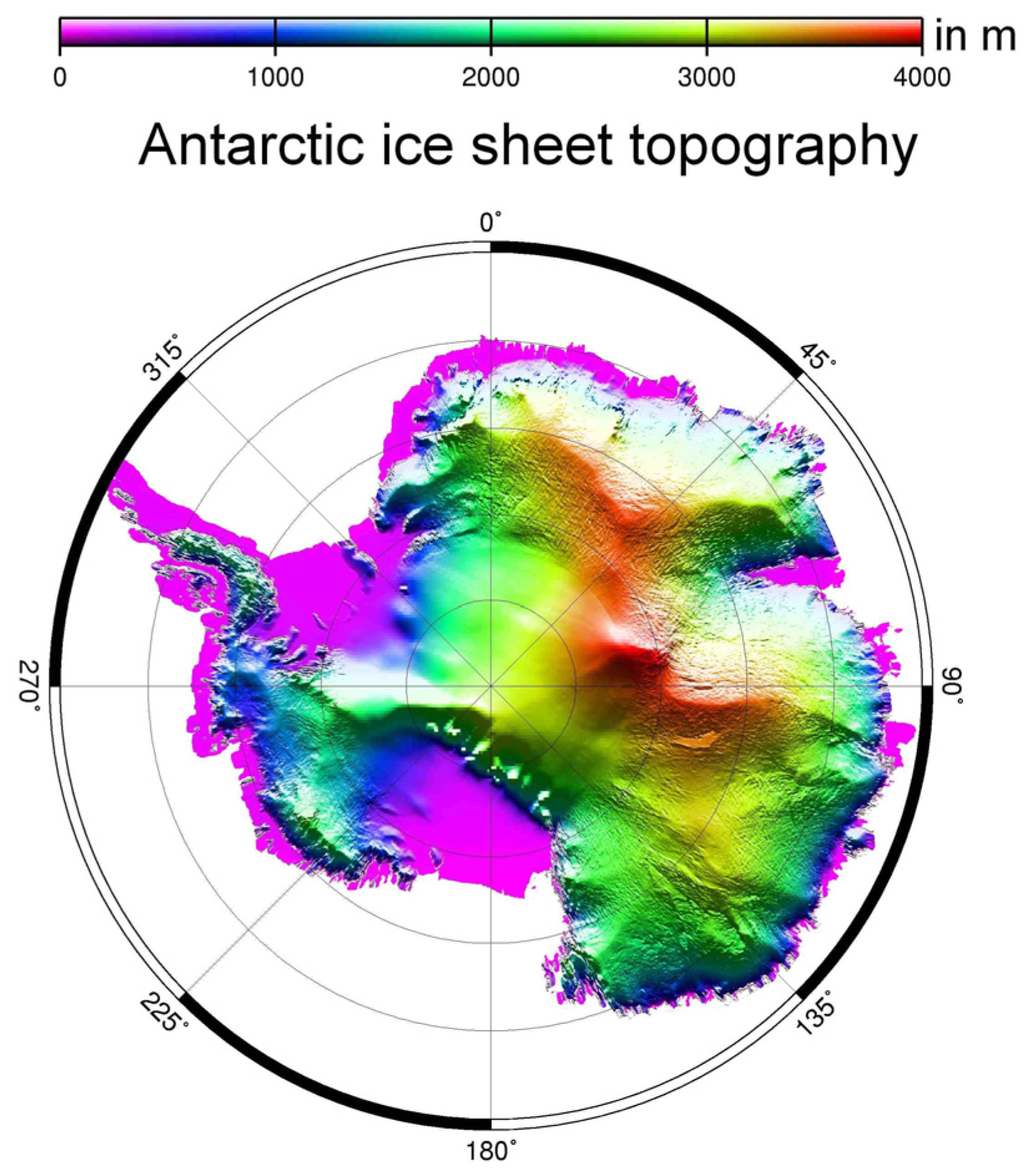
4.3. Subglacial Lakes and Hydrological Networks
4.4. Balance Velocity and Ice Dynamics
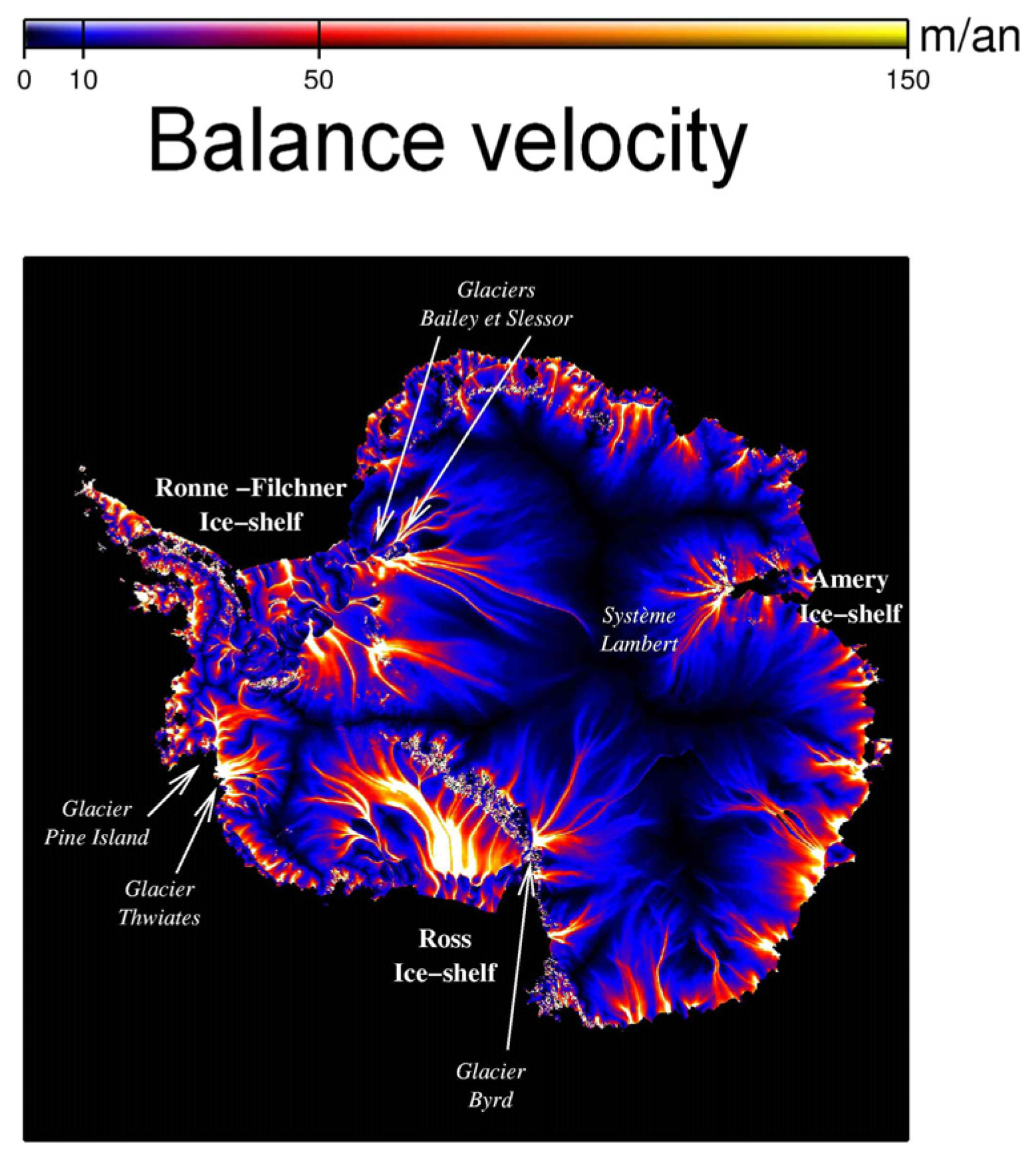
5. Ice Sheet Mass Balance
5.1. Methodology and Error Budget
5.2. Monitoring the Small Scale Features
5.3. Monitoring Antarctic Ice Sheet at the Global Scale

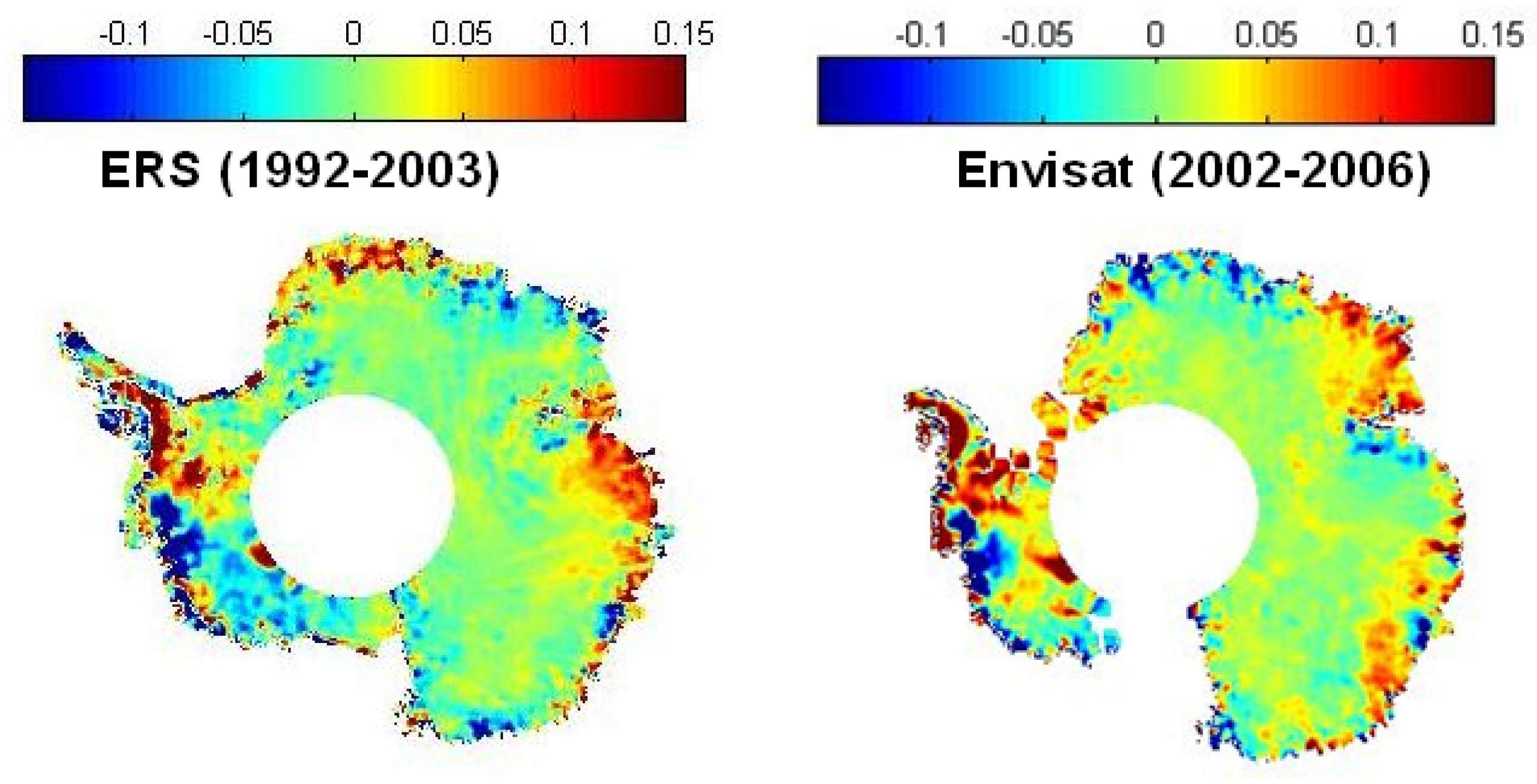
6. Conclusions
Acknowledgments
References and Notes
- Meier, M.F. Ice, climate, and sea level: do we know what is happening? In Ice in the Climate System; Peltier, W.R., Ed.; Springer-Verlag, NATO ASI Series: Berlin, Germany, 1993; Volume 1-12, pp. 141–160. [Google Scholar]
- Paterson, W.S.B. The Physics of the Glacier, 3rd ed.; Butterworth-Heineman-Oxford Press: London, UK, 1994; p. 480. [Google Scholar]
- Vaughan, D.G.; Bamber, J.L.; Giovinetto, M.; Russell, J.; Cooper, A.P.R. Reassessment of net surface mass balance in Antarctica. J. Climate 1999, 12, 933–946. [Google Scholar] [CrossRef]
- Jouzel, J.; Masson-Delmotte, V.; Cattani, O.; Dreyfus, G.; Falourd, S.; Hoffmann, G.; Minster, B.; Nouet, J.; Barnola, J.M.; Chappellaz, J.; Fischer, H.; Gallet, J.C.; Johnsen, S.; Leuenberger, M.; Loulergue, L.; Luethi, D.; Oerter, H.; Parrenin, F.; Raisbeck, G.; Raynaud, D.; Schilt, A.; Schwander, J.; Selmo, E.; Souchez, R.; Spahni, R.; Stauffer, B.; Steffensen, J.P.; Stenni, B.; Stocker, T.F.; Tison, J.L.; Werner, M.; Wolff, E.W. Orbital and millennial Antarctic climate variability over the past 800,000 years. Science 2007, 317, 793–796. [Google Scholar] [CrossRef] [PubMed] [Green Version]
- Eisen, O.; Frezzotti, M.; Genthon, C.; Isaksson, E.; Magand, O.; van den Broeke, M.R.; Dixon, D.A.; Ekaykin, A.; Holmlund, P.; Kameda, T.; Karlof, L.; Kaspari, S.; Lipenkov, V.Y.; Oerter, H.; Takahashi, S.; Vaughan, D.G. Ground-based measurements of spatial and temporal variability of snow accumulation in east Antarctica. Rev. Geophys. 2008, 46, 1–39. [Google Scholar] [CrossRef]
- Frezzotti, M.; Pourchet, M.; Flora, O.; Gandolfi, S.; Gay, M.; Urbini, S.; Vincent, C.; Becagli, S.; Gragnani, R.; Proposito, M.; Severi, M.; Traversi, R.; Udisti, R.; Fily, M. Spatial and temporal variability of snow accumulation in East Antarctica from traverse data. J. Glaciol. 2005, 51, 113–124. [Google Scholar] [CrossRef]
- Remy, F.; Frezzotti, M. Antarctica ice sheet mass balance. C. R. Geosci. 2006, 338, 1084–1097. [Google Scholar] [CrossRef]
- Cavalieri, D.J.; Parkinson, C.L. Antarctic sea ice variability and trends, 1979-2006. J. Geophys. Res.-Oceans 2008, 113, 1084–1097. [Google Scholar] [CrossRef]
- Bindschadler, R. Monitoring ice sheet behavior from space. Rev. Geophys. 1998, 36, 79–104. [Google Scholar] [CrossRef]
- Masson, R.; Lubin, D. Polar Remote Sensing; Springer: Berlin, Germany, 2006; p. 426. [Google Scholar]
- Kerr, A. Topography, climate and ice masses—a review. Terra Nova 1993, 5, 332–342. [Google Scholar] [CrossRef]
- Remy, F.; Legresy, B.; Testut, L. Ice sheet and satellite altimetry. Surv. Geophys. 2001, 22, 1–29. [Google Scholar] [CrossRef]
- Fu, L.L.; Cazenave, A. Satellite Altimetry and Earth Sciences: A Handbook of Techniques and Applications; Academic Press: San Diego, CA, USA, 2001. [Google Scholar]
- Fu, L.L.; Christensen, E.J.; Yamarone, C.A.; Lefebvre, M.; Menard, Y.; Dorrer, M.; Escudier, P. Topex/poseidon mission overview. J. Geophys Res.-Oceans 1994, 99, 24369–24381. [Google Scholar] [CrossRef]
- Cazenave, A.; Schaeffer, P.; Berge, M.; Brossier, C.; Dominh, K.; Gennero, M.C. High-resolution mean sea surface computed with altimeter data of ERS-1 (geodetic mission) and Topex-Poseidon. Geophys. J. Int. 1996, 125, 696–704. [Google Scholar] [CrossRef]
- Cazenave, A.; Nerem, R.S. Present-day sea level change: observations and causes. Rev. Geophys. 2004, 42, 1–20. [Google Scholar] [CrossRef]
- Brooks, R.L.; Campbell, W.J.; Ramseier, R.O.; Stanley, H.R.; Zwally, H.J. Ice sheet topography by satellite altimetry. Nature 1978, 274, 539–543. [Google Scholar] [CrossRef]
- Brenner, A.C.; Bindschadler, R.A.; Thomas, R.H.; Zwally, H.J. Slope-induced errors in radar altimetry over continental ice sheets. J. Geophys. Res.-Ocean. Atmos. 1983, 88, 1617–1623. [Google Scholar] [CrossRef]
- Roemer, S.; Legresy, B.; Horwath, M.; Dietrich, R. Refined analysis of radar altimetry data applied to the region of the subglacial Lake Vostok/Antarctica. Remote Sens. Environ. 2007, 106, 269–284. [Google Scholar] [CrossRef]
- Brenner, A.C.; DiMarzio, J.R.; Zwally, H.J. Precision and accuracy of satellite radar and laser altimeter data over the continental ice sheets. IEEE Trans. Geosci. Remot. Sen. 2007, 45, 321–331. [Google Scholar] [CrossRef]
- Remy, F.; Mazzega, P.; Houry, S.; Brossier, C.; Minster, J.F. Mapping of the topography of continental ice by inversion of satellite-altimeter data. J. Glaciol. 1989, 35, 98–107. [Google Scholar] [CrossRef]
- Bamber, J. Analysis of satellite-altimeter height measurements above continental ice sheets. J. Glaciology 1995, 41, 206–206. [Google Scholar]
- Martin, T.V.; Zwally, H.J.; Brenner, A.C.; Bindschadler, R.A. Analysis and retracking of continental ice-sheet radar altimeter waveforms. J. Geophys. Res.-Ocean. Atmos. 1983, 88, 1608–1616. [Google Scholar] [CrossRef]
- Brenner, A.C.; Koblinsky, C.J.; Zwally, H.J. Postprocessing of satellite altimetry return signals for imporved sea-surface topography accuracy. J. Geophys. Res.-Oceans 1993, 98, 933–944. [Google Scholar] [CrossRef]
- Femenias, P.; Remy, F.; Raizonville, R.; Minster, J.F. Analysis of satellite-altimeter heigth measurements above continental ice sheets. J. Glaciol. 1993, 39, 591–600. [Google Scholar]
- Wingham, D.J. The limiting resolution of ice-sheet elevations derived from pulse-limited satellite altimetry. J. Glaciol. 1995, 41, 413–422. [Google Scholar]
- Legresy, B.; Remy, F. Altimetric observations of surface characteristics of the Antarctic ice sheet. J. Glaciol. 1997, 43, 265–275. [Google Scholar]
- Ridley, J.K.; Partington, K.C. A model of satellite radar altimeter return from ice sheets. Int. J. Remote Sens. 1988, 9, 601–624. [Google Scholar] [CrossRef]
- Zwally, H.J.; Bindschadler, R.A.; Brenner, A.C.; Martin, T.V.; Thomas, R.H. Surface elevation contours of Greenland and Antarctic ice sheets. J. Geophys. Res.-Ocean. Atmos. 1983, 88, 1589–1596. [Google Scholar] [CrossRef]
- Matzler, C.; Wegmuller, U. Applications of the interaction of microwaves with the natural snow cover. Remote Sens. Rev. 1987, 2, 259–391. [Google Scholar] [CrossRef]
- Zwally, H.J. Microwave emissivity and accumulation rate of polar firn. J. Glaciol. 1977, 18, 195–215. [Google Scholar]
- Fung, A.K.; Eom, H.J. Application of a combined rough-surface and volume scattring theory to sea ice and snow backscatter. IEEE Trans. Geosci. Remot. Sen. 1982, 20, 528–536. [Google Scholar] [CrossRef]
- Tiuri, M.E.; Sihvola, A.H.; Nyfors, E.G.; Hallikaiken, M.T. The complex dielectric constant of snow at microwave frequencies. IEEE J. Oceanic Eng. 1984, 9, 377–382. [Google Scholar] [CrossRef]
- Rott, H.; Sturm, K.; Miller, H. Active and passive microwave signatures of Antarctic firn by means of field measurements and satellite data. Ann. Glaciol. 1993, 17, 337–343. [Google Scholar]
- Remy, F.; Femenias, P.; Ledroit, M.; Minster, J.F. Empirical microwave backscattering over Antarctica: Application to radar altimetry. J. Electromagnet Wave Applicat. 1995, 9, 463–474. [Google Scholar]
- Partington, K.C.; Ridley, J.K.; Rapley, C.G.; Zwally, H.J. Observations of the surface properties of the ice sheets by satellite radar altimetry. J. Glaciol. 1989, 35, 267–275. [Google Scholar]
- Remy, F.; Brossier, C.; Minster, J.F. Intensity of satellite radar-altimeter return power over continental ice. A potential measurement of katabatic wind intensity. J. Glaciol. 1990, 36, 133–142. [Google Scholar]
- Legresy, B.; Remy, F. Altimetric observations of surface characteristics of the Antarctic ice sheet. J. Glaciol. 1997, 43, 265–275. [Google Scholar]
- Davis, C.H.; Zwally, H.J. Geographic and seasonal variations in the surface properties of the ice sheets by satellite radar altimetry. J. Glaciol. 1993, 39, 687–697. [Google Scholar]
- Lacroix, P.; Dechambre, M.; Legresy, B.; Blarel, F.; Remy, F. On the use of the dual-frequency ENVISAT altimeter to determine snowpack properties of the Antarctic ice sheet. Remote Sens. Environ. 2008, 112, 1712–1729. [Google Scholar] [CrossRef]
- Legresy, B.; Remy, F. Using the temporal variability of satellite radar altimetric observations to map surface properties of the Antarctic ice sheet. J. Glaciol. 1998, 44, 197–206. [Google Scholar]
- Davis, C.H. Temporal change in the extinction coefficient of snow on the Greenland ice sheet from an analysis of seasat and geosat altimeter data. IEEE Trans. Geosci. Remot. Sen. Symp. 1996, 34, 1066–1073. [Google Scholar] [CrossRef]
- Arthern, R.J.; Wingham, D.J. The natural fluctuations of firn densification and their effect on the geodetic determination of ice sheet mass balance. Climatic Change 1998, 40, 605–624. [Google Scholar] [CrossRef]
- Zwally, H.J.; Jun, L. Seasonal and interannual variations of firn densification and ice-sheet surface elevation at the Greenland summit. J. Glaciol. 2002, 48, 199–207. [Google Scholar] [CrossRef]
- Li, J.; Zwally, H.J. Modeling the density variation in the shallow firn layer. Ann. Glaciol. 2004, 38, 309–313. [Google Scholar] [CrossRef]
- Alley, R.B. Firn densification by grain boundary sliding. A 1st model. J. Phys-Paris 1987, 48, 249–256. [Google Scholar] [CrossRef]
- Helsen, M.M.; van den Broeke, M.R.; van de Wal, R.S.W.; van de Berg, W.J.; van Meijgaard, E.; Davis, C.H.; Li, Y.H.; Goodwin, I. Elevation changes in Antarctica mainly determined by accumulation variability. Science 2008, 320, 1626–1629. [Google Scholar] [CrossRef] [PubMed]
- Remy, F.; Parrenin, F. Snow accumulation variability and random walk: how to interpret changes of surface elevation in Antarctica. Earth Planet. Sci. Lett. 2004, 227, 273–280. [Google Scholar] [CrossRef]
- Remy, F.; Legresy, B.; Bleuzen, S.; Vincent, P.; Minster, J.F. Dual-frequency Topex altimeter observations of Greenland. J. Electromagnet. Wave. Applicat. 1996, 10, 1507–1525. [Google Scholar] [CrossRef]
- Legresy, B.; Papa, F.; Remy, F.; Vinay, G.; van den Bosch, M.; Zanife, O.Z. ENVISAT radar altimeter measurements over continental surfaces and ice caps using the ICE-2 retracking algorithm. Remote Sens. Environ. 2005, 95, 150–163. [Google Scholar] [CrossRef]
- Lacroix, P.; Legresy, B.; Coleman, R.; Dechambre, M.; Remy, F. Dual-frequency altimeter signal from Envisat on the Amery ice-shelf. Remote Sens. Environ. 2007, 109, 285–294. [Google Scholar] [CrossRef]
- Fedor, L.S. Seasat radar altimeter measurements of significant wave height. Trans. Am. Geophys. Union 1978, 59, 1095–1095. [Google Scholar]
- Chelton, D.B.; McCabe, P.J. A review of satellite altimeter measurement of sea-surface wind-speed - with a proposed new algorithm. J. Geophys. Res.-Oceans 1985, 90, 4707–4720. [Google Scholar] [CrossRef]
- Chelton, D.B.; Wentz, F.J. Further develoment of an improved altimeter wind-speed algorithm. J. Geophys. Res.-Oceans 1986, 91, 14250–14260. [Google Scholar] [CrossRef]
- Monaldo, F.; Dobson, E. On using significant wave heigth and radar cross-section to improve radar altimeter measurements of wind-speed. J. Geophys. Res.-Oceans 1989, 94, 12699–12701. [Google Scholar] [CrossRef]
- Bintanja, R. On the glaciological, meteorological, and climatological significance of Antarctic blue ice areas. Rev. Geophys. 1999, 37, 337–359. [Google Scholar] [CrossRef]
- Long, D.G.; Drinkwater, M. Microwave wind direction retrieval over Antarctica. In Proceedings of IEEE 2000 International Geoscience and Remote Sensing Symposium, Honolulu, HI, USA; July 2000; pp. 1137–1139. [Google Scholar]
- Swift, C.T.; Cavalieri, D.J.; Gloersen, P.; Zwally, H.J.; Mognard, N.M.; Campbell, W.J.; Fedor, L.S.; Peteherych, S. Observations of the polar-regions from satellites using active and passive microwave techniques. Advan. Geophys. 1985, 27, 335–392. [Google Scholar]
- Jezek, K.C.; Alley, R.B. Effect of stratigraphy on radar-altimetry data collected over ice sheets. Ann. Glaciol. 1988, 11, 60–62. [Google Scholar]
- Flach, J.D.; Partington, K.C.; Ruiz, C.; Jeansou, E.; Drinkwater, M.R. Inversion of the surface properties of ice sheets from satellite microwave data. IEEE Trans. Geosci. Remote Sens. 2005, 43, 743–752. [Google Scholar] [CrossRef]
- Lacroix, P.; Legresy, B.; Langley, K.; Hamran, S.E.; Kohler, J.; Roques, S.; Remy, F.; Dechambre, M. In situ measurements of snow surface roughness using a laser profiler. J. Glaciol. 2008, 54, 753–762. [Google Scholar] [CrossRef]
- Remy, F.D.; Shaeffer, P.; Legresy, B. Ice flow physical processes derived from the ERS-1 high-resolution map of the Antarctica and Greenland ice sheets. Geophy. J. Int. 1999, 139, 645–656. [Google Scholar] [CrossRef]
- Schutz, B.E.; Zwally, H.J.; Shuman, C.A.; Hancock, D.; DiMarzio, J.P. Overview of the ICESat Mission. Geophys. Res. Lett. 2005, 32, 1–4. [Google Scholar] [CrossRef]
- Bamber, J.; Gomez-Dans, J.L. The accuracy of digital elevation models of the Antarctic continent. Earth Planet. Sci. Lett. 2005, 237, 516–523. [Google Scholar] [CrossRef]
- Phillips, H.A.; Allison, I.; Coleman, R.; Hyland, G.; Morgan, P.J.; Young, N.W. Comparison of ERS satellite radar altimeter heights with GPS-derived heights on the Amery Ice Shelf, East Antarctica. Ann. Glaciol. 1998, 27, 19–24. [Google Scholar]
- Drewry, D.J.; Robin, G. Form and flow of the Antarctic ice sheet during the last million years. In The climatic record in polar ice sheets; Robin, G.d.Q., Ed.; Cambridge University Press: London, UK, 1983; pp. 28–38. [Google Scholar]
- Vaughan, D.G.; Bamber, J.L. Identifying areas of low-profile ice sheet and outcrop damming in the Antarctic ice sheet by ERS-1 satellite altimetry. Ann. Glaciol. 1998, 27, 1–6. [Google Scholar]
- Remy, F.; Minster, J.F. Antarctica ice sheet curvature and its relation with ice flow and boundary conditions. Geophys. Res. Lett. 1997, 24, 1039–1042. [Google Scholar] [CrossRef]
- Budd, W.F. Stress variations with ice flow over undulations. J. Glaciol. 1971, 9, 29–48. [Google Scholar]
- McIntyre, N.F. The Antarctic ice sheet topography and surface bedrock relationship. Ann. Glaciol. 1986, 8, 124–128. [Google Scholar]
- Robin, G.d.Q.; Swithinbank, C.W.M.; Smith, B.M.E. Radio echo exploration of the Antarctic ice sheet. In Proceedings of International Symposium on Antarctic Glaciological Exploration, Hanover, NH, USA; 1968. [Google Scholar]
- Dowdeswell, J.A.; Siegert, M.J. The dimensions and topographic setting of Antarctic subglacial lakes and implications for large-scale water storage beneath continental ice sheets. Geol. Soc. Amer. Bull. 1999, 111, 254–263. [Google Scholar] [CrossRef]
- Ridley, J.K.; Cudlip, W.; Laxon, S.W. Identification of subglacial lakes using ERS-1 radar altimeter. J. Glaciol. 1993, 39, 625–634. [Google Scholar]
- Le Brocq, A.M.; Hubbard, A.; Bentley, M.J.; Bamber, J.L. Subglacial topography inferred from ice surface terrain analysis reveals a large un-surveyed basin below sea level in East Antarctica. Geophys. Res. Lett. 2008, 35, 1–6. [Google Scholar] [CrossRef]
- Siegert, M.J. Antarctic subglacial lakes. Earth-Sci. Rev. 2000, 50, 29–50. [Google Scholar] [CrossRef]
- Siegert, M.J.; Carter, S.; Tabacco, I.; Popov, S.; Blankenship, D.D. A revised inventory of Antarctic subglacial lakes. Antarct. Sci. 2005, 17, 453–460. [Google Scholar] [CrossRef]
- Bell, R.E.; Studinger, M.; Shuman, C.A.; Fahnestock, M.A.; Joughin, I. Large subglacial lakes in East Antarctica at the onset of fast-flowing ice streams. Nature 2007, 445, 904–907. [Google Scholar] [CrossRef] [PubMed]
- Fricker, H.A.; Scambos, T.; Bindschadler, R.; Padman, L. An active subglacial water system in West Antarctica mapped from space. Science 2007, 315, 1544–1548. [Google Scholar] [CrossRef] [PubMed]
- Priscu, J. Subglacial lakes have changed our view of Antarctica. Antarct. Sci. 2002, 14, 291–291. [Google Scholar]
- Vaughan, D.G.; Rivera, A.; Woodward, J.; Corr, H.F.J.; Wendt, J.; Zamora, R. Topographic and hydrological controls on subglacial Lake Ellsworth, west Antarctica. Geophys. Res. Lett. 2007, 34, 1–5. [Google Scholar] [CrossRef]
- Remy, F.; Tabacco, I.E. Bedrock features and ice flow near the EPICA ice core site (Dome C, Antarctica). Geophys.Res. Lett. 2000, 27, 405–408. [Google Scholar] [CrossRef]
- Remy, F.; Legresy, B. Subglacial hydrological networks in Antarctica and their impact on ice flow. Ann. Glaciol. 2004, 39, 67–72. [Google Scholar] [CrossRef]
- Lythe, M.B.; Vaughan, D.G. BEDMAP: A new ice thickness and subglacial topographic model of Antarctica. J. Geophys. Res.-Solid Earth 2001, 106, 11335–11351. [Google Scholar] [CrossRef]
- Budd, W.F.; Warner, R.C. A computer scheme for rapid calculations of balance-flux distributions. Ann. Glaciol. 1996, 23, 21–27. [Google Scholar]
- Testut, L.; Hurd, R.; Coleman, R.; Remy, F.; Legresy, B. Comparison between computed balance velocities and GPS measurements in the Lambert Glacier basin, East Antarctica. Ann. Glaciol. 2003, 37, 337–343. [Google Scholar] [CrossRef]
- Bamber, J.L.; Huybrechts, P. Geometric boundary conditions for modelling the velocity field of the Antarctica ice sheet. Ann. Glaciol. 1996, 23, 364–373. [Google Scholar]
- Budd, W.F.; Jacka, T.H. A review of ice rhelogy for ice sheet modelling. Cold Reg. Sci. Technol. 1989, 16, 107–144. [Google Scholar] [CrossRef]
- Young, N.W.; Goodwin, I.D.; Hazelton, N.W.J.; Thwaites, R.J. Measured velocities and ice flow in Wilkes land, Antarctica. Ann. Glaciol. 1989, 12, 192–197. [Google Scholar]
- Rémy, F.; Ritz, C.; Brisset, L. Ice sheet flow features and rheological parameters derived from precise altimetric topography. Ann. Glaciol. 1996, 23, 277–283. [Google Scholar]
- Testut, L.; Tabacco, I.E.; Bianchi, C.; Remy, F. Influence of geometrical boundary conditions on the estimation of rheological parameters. Ann. Glaciol. 2000, 30, 102–106. [Google Scholar] [CrossRef]
- Parrenin, F.; Hindmarsh, R. Influence of a non-uniform velocity field on isochrone geometry along a steady flowline of an ice sheet. J. Glaciol. 2007, 53, 612–622. [Google Scholar] [CrossRef]
- Parrenin, F.; Remy, F.; Ritz, C.; Siegert, M.J.; Jouzel, J. New modeling of the Vostok ice flow line and implication for the glaciological chronology of the Vostok ice core. J. Geophys. Res.-Atmos. 2004, 109. [Google Scholar] [CrossRef]
- Berthier, E.; Raup, B.; Scambos, T. New velocity map and mass-balance estimate of Mertz Glacier, East Antarctica, derived from Landsat sequential imagery. J. Glaciol. 2003, 49, 503–511. [Google Scholar] [CrossRef]
- Fricker, H.A.; Warner, R.C.; Allison, I. Mass balance of the Lambert Glacier-Amery Ice Shelf system, East Antarctica: a comparison of computed balance fluxes and measured fluxes. J. Glaciol. 2000, 46, 561–570. [Google Scholar] [CrossRef]
- Giovinetto, M.B.; Waters, N.M.; Bentley, C.R. Dependence of Antarctic surface mass balance on temperature, elevation and distance to open ocean. J. Geophys. Res.-Atmos. 1990, 95, 3517–3531. [Google Scholar] [CrossRef]
- Bamber, J.L.; Rivera, A. A review of remote sensing methods for glacier mass balance determination. Global Planet. Change 2007, 59, 138–148. [Google Scholar] [CrossRef]
- Arthern, R.J.; Hindmarsh, R.C.A. Optimal estimation of changes in the mass of ice sheets. J. Geophys. Res.-Earth Surf. 2003, 108, 1–16. [Google Scholar] [CrossRef]
- Zwally, H.J.; Giovinetto, M.B.; Li, J.; Cornejo, H.G.; Beckley, M.A.; Brenner, A.C.; Saba, J.L.; Yi, D.H. Mass changes of the Greenland and Antarctic ice sheets and shelves and contributions to sea-level rise: 1992-2002. J. Glaciol. 2005, 51, 509–527. [Google Scholar] [CrossRef]
- Wingham, D.J.; Shepherd, A.; Muir, A.; Marshall, G.J. Mass balance of the Antarctic ice sheet. Phil. Trans. Royal Soc. A 2006, 364, 1627–1635. [Google Scholar] [CrossRef] [PubMed]
- Legrésy, B.; Rémy, F.; Blarel, F. Along track repeat altimetry for ice sheets and continental surface studies. In Proceedings of ESA Symposium, 15 years of satellite altimetry, Venice, Italy; 2006. [Google Scholar]
- Davis, C.H.; Ferguson, A.C. Elevation change of the Antarctic ice sheet, 1995-2000, from ERS-2 satellite radar altimetry. IEEE Trans. Geosci. Remot. Sen. 2004, 42, 2437–2445. [Google Scholar] [CrossRef]
- Remy, F.; Legresy, B.; Benveniste, J. On the azimuthally anisotropy effects of polarization for altimetric measurements. IEEE Trans. Geosci. Remot. Sen. 2006, 44, 3289–3296. [Google Scholar] [CrossRef]
- Wingham, D.J.; Siegert, M.J.; Shepherd, A.; Muir, A.S. Rapid discharge connects Antarctic subglacial lakes. Nature 2006, 440, 1033–1036. [Google Scholar] [CrossRef] [PubMed]
- Stearns, L.A.; Smith, B.E.; Hamilton, G.S. Increased flow speed on a large East Antarctic outlet glacier caused by subglacial floods. Nat. Geosci. 2008, 1, 827–831. [Google Scholar] [CrossRef]
- Bell, R.E. The role of subglacial water in ice-sheet mass balance. Nat. Geosci. 2008, 1, 297–304. [Google Scholar] [CrossRef]
- Shepherd, A.; Wingham, D.J.; Mansley, J.A.D. Inland thinning of the Amundsen Sea sector, West Antarctica. Geophys. Res. Lett. 2002, 29. [Google Scholar] [CrossRef]
- Shepherd, A.; Wingham, D.J.; Mansley, J.A.D.; Corr, H.F.J. Inland thinning of Pine Island Glacier, West Antarctica. Science 2001, 291, 862–864. [Google Scholar] [CrossRef] [PubMed]
- Thomas, R.; Rignot, E.; Casassa, G.; Kanagaratnam, P.; Acuna, C.; Akins, T.; Brecher, H.; Frederick, E.; Gogineni, P.; Krabill, W.; Manizade, S.; Ramamoorthy, H.; Rivera, A.; Russell, R.; Sonntag, J.; Swift, R.; Yungel, J.; Zwally, J. Accelerated sea-level rise from West Antarctica. Science 2004, 306, 255–258. [Google Scholar] [CrossRef] [PubMed]
- Herzfeld, U.C.; McBride, P.J.; Zwally, H.J.; Dimarzio, J. Elevation changes in Pine Island Glacier, Walgreen Coast, Antarctica, based on GLAS (2003) and ERS-1 (1995) altimeter data analyses and glaciological implications. Int. J. Remote Sens. 2008, 29, 5533–5553. [Google Scholar] [CrossRef]
- Wingham, D.; Wallis, D.; Shepherd, A. Spatial and temporal evolution of Pine Island Glacier thinning, 1995-2006. Geophys. Res. Lett. 2009, 36, 1–5. [Google Scholar] [CrossRef]
- Shepherd, A.; Wingham, D.; Payne, T.; Skvarca, P. Larsen ice shelf has progressively thinned. Science 2003, 302, 856–859. [Google Scholar] [CrossRef] [PubMed]
- King, M.A.; Coleman, R.; Freemantle, A.J.; Fricker, H.A.; Hurd, R.S.; Legresy, B.; Padman, L.; Warner, R. A 4-decade record of elevation change of the Amery Ice Shelf, East Antarctica. J. Geophys. Res.-Earth Surf. 2009, 114, 13–29. [Google Scholar] [CrossRef]
- Llubes, M.; Lanseau, C.; Remy, F. Relations between basal condition, subglacial hydrological networks and geothermal flux in Antarctica. Earth Planet. Sci. Lett. 2006, 241, 655–662. [Google Scholar] [CrossRef]
- Pritchard, H.D.; Arthern, R.J.; Vaughan, D.G.; Edwards, L.A. Extensive dynamic thinning on the margins of the Greenland and Antarctic ice sheets. Nature 2009, 461, 971–975. [Google Scholar] [CrossRef] [PubMed]
- Shepherd, A.; Wingham, D. Recent sea-level contributions of the Antarctic and Greenland ice sheets. Science 2007, 315, 1529–1532. [Google Scholar] [CrossRef] [PubMed]
- Shepherd, A.; Wingham, D. Antarctic glacier thinning, 1992-2003. Scott. Geogr. J. 2008, 124, 154–164. [Google Scholar] [CrossRef]
- Korona, J.; Berthier, E.; Bernard, M.; Remy, F.; Thouvenot, E. SPIRIT. SPOT 5 stereoscopic survey of Polar Ice: Reference Images and Topographies during the fourth International Polar Year (2007-2009). Isprs J. Photogramm. 2009, 64, 204–212. [Google Scholar] [CrossRef] [Green Version]
- Wingham, D.J.; Francis, C.R.; Baker, S.; Bouzinac, C.; Brockley, D.; Cullen, R.; de Chateau-Thierry, P.; Laxon, S.W.; Mallow, U.; Mavrocordatos, C.; Phalippou, L.; Ratier, G.; Rey, L.; Rostan, F.; Viau, P.; Wallis, D.W. CryoSat: A mission to determine the fluctuations in Earth's land and marine ice fields. In Proceedings of 35th COSPAR Scientific Assembly, Paris, France; 2004; pp. 841–871. [Google Scholar]
- Thomas, R.; Davis, C.; Frederick, E.; Krabill, W.; Li, Y.H.; Manizade, S.; Martin, C. A comparison of Greenland ice-sheet volume changes derived from altimetry measurements. J. Glaciol. 2008, 54, 203–212. [Google Scholar] [CrossRef]
- Kouraev, A.V.; Semovski, S.V.; Shimaraev, M.N.; Mognard, N.M.; Legresy, B.; Remy, F. Observations of Lake Baikal ice from satellite altimetry and radiometry. Remote Sens. Environ 2007, 108, 240–253. [Google Scholar] [CrossRef]
- Papa, F.; Legresy, B.; Remy, F. Use of the Topex-Poseidon dual-frequency radar altimeter over land surfaces. Remote Sens. Environ. 2003, 87, 136–147. [Google Scholar] [CrossRef]
© 2009 by the authors; licensee Molecular Diversity Preservation International, Basel, Switzerland. This article is an open-access article distributed under the terms and conditions of the Creative Commons Attribution license (http://creativecommons.org/licenses/by/3.0/).
Share and Cite
Rémy, F.; Parouty, S. Antarctic Ice Sheet and Radar Altimetry: A Review. Remote Sens. 2009, 1, 1212-1239. https://doi.org/10.3390/rs1041212
Rémy F, Parouty S. Antarctic Ice Sheet and Radar Altimetry: A Review. Remote Sensing. 2009; 1(4):1212-1239. https://doi.org/10.3390/rs1041212
Chicago/Turabian StyleRémy, Frédérique, and Soazig Parouty. 2009. "Antarctic Ice Sheet and Radar Altimetry: A Review" Remote Sensing 1, no. 4: 1212-1239. https://doi.org/10.3390/rs1041212



